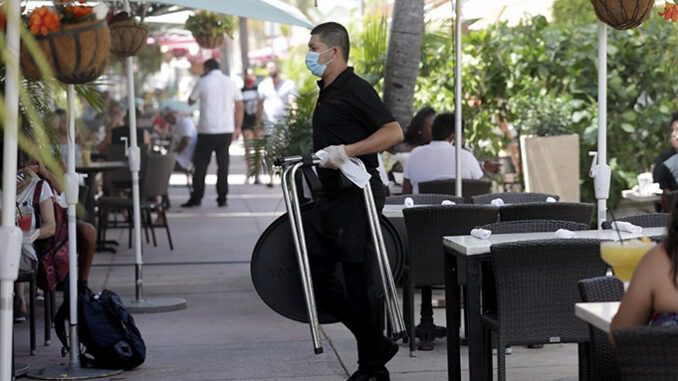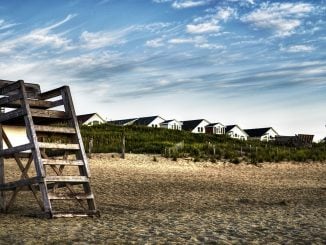
RALEIGH — Now that most parts of the nation’s economy have been allowed to reopen, restaurants across North Carolina are operating at up to 50% seating capacity. Still most customers are choosing to sit outside and many in the industry are nervous the upcoming fall and winter will put a dent in their businesses. As North Carolina A&T State University Economist Alfredo A. Romero recently said in an interview with the Wall Street Journal, “the question remains if people will be willing to come back, to eat at a restaurant or shop at a mall, especially now that the colder weather is coming and cases are rising.”
Over the last several months, since stay-at-home orders were first lifted, Triangle area restaurant owners have relied heavily on tents and outdoor dining spaces to increase seating capacity and boost lost revenue. For example in Durham, a group of restaurants banded together to start the Downtown Durham Streetery, a dining block party of sorts where local eateries set up their patios for dinner on the weekends drawing throngs of customers eager to eat outdoors, shop, get carry-out, and sometimes even dine in.
Similarly, almost every night of the week, Raleigh’s Glenwood South neighborhood is packed with outdoor diners taking advantage of tents and electric heaters. Employees at the Cortez say they were nearly forced to close for good last March due to COVID shutdown measures, but since then their outdoor patio and tents have allowed them to accommodate enough guests to stay profitable and replenish lost funds. Their hostess says they seat up to 50 on weekdays and 100 on weekends, thanks to the utilization of an outdoor dining area. Come colder weather, the restaurant plans on covering and zipping up their tents and adding heaters but have no plans to change things any time soon. Still even this model begs the question of whether people who are reluctant to eat indoors during a pandemic will also be somewhat skeptical of dining inside a giant heated zipped up bubble in just a few weeks’ time.
Business owners are concerned the arrival of cold weather could bring morale back down and scare patrons away. “I don’t think I have ever been more concerned about the weather in my entire life … we watch the weather every day,” says Elizabeth Turnbull, co-owner of Durham’s Copa which is one of the restaurants involved in the Downtown Streetery. “Percentage of rain, what is the low temperature? What is the high temperature? It all matters especially when half or more of your business depends on outdoor dining.”
French inspired Coquette in Raleigh’s North Hills has overtaken a giant section of their shared parking lot to set up tents and serve customers. Manager Marcus Finotti says that while they can seat up to 118 patrons inside even while operating at only 50% capacity, “people overwhelmingly feel safer sitting outside, which is why we do not take reservations out there.” Finotti acknowledges the colder temperatures could make them rethink their set up.
“Percentage of rain, what is the low temperature? What is the high temperature? It all matters especially when half or more of your business depends on outdoor dining.”
Elizabeth Turnbull, co-owner of Durham’s Copa
The Glenwood Grill’s acting manager Ellie Jarman says they have also set up tents with heaters for outdoor dining and are doing all things possible to keep people warm and cozy heading into colder weather but that even with these things in place come January people aren’t going to want to sit outside so she anticipates they will lose some customers. A recent report from Goldman Sachs Group Inc. indicated that 45F (7.2C) is the temperature below which demand for outdoor dining essentially collapses. The good news for local restaurant owners in our area however is that this region usually doesn’t see a drastic drop until later fall or early winter.
In contrast, temps have already reached the 40’s in the Northeast, so places like Talulla in Cambridge, Mass., began introducing cold-weather menu items in addition to heat lamps. Dishes such as braised short ribs and cassoulet served in eight-inch cast iron pans are selling well. In Denver, where it’s already snowing, chef Cody Cheetham of Tavernetta has started serving braised elk shoulder, oven-baked pastas and other warm, hearty dishes that stay hot for a while. The town’s Beast + Bottle, has put hot soup on the menu for the first time, and a pot pie according to chef Paul Reilly. Reilly is also starting to emphasize braises, such as pork shoulder and squash in fennel seed broth. Cheese fondue, popular for warming up skiers fresh off the slopes has apparently also made a comeback.
If North Carolina restaurants are forced to close down outdoor seating in the months ahead, one option to boost revenue could be an even greater focus on to-go orders. Since March when stay-at-home orders were first rolled out, many restaurants have totally reinvented themselves through expanded takeout and prepared food meal options. In nearby Carrboro, Acme Food and Beverage chef and owner Kevin Callaghan collaborated with a group of other restaurateurs to create Carrboro United a one-stop shop for produce, fresh meat and prepared foods, where customers order online and pickup from a shared location three times a week. Items may include boeuf bourguignon for four, two dozen eggs from a local farm or a pizza kit from the well-known Amante Gourmet Pizza. Masked workers bring customers’ orders to their cars. “Restaurants provide hospitality. One piece of that is convenience and one piece is service,” Mr. Callaghan said in an interview. “This had to be easy for the guests. There was no way it was going to work if it was hard.”
Despite going to great lengths to prepare for the onset of winter and expand their business models to adapt to COVID’s “new normal,” eating establishments say much of this still remains out of their control. Glenwood Grill’s Jarman says it is not the onset of colder weather that is worrisome but rather the governor’s mandatory capacity restrictions that are holding her industry back from a full recovery. “If somehow we miraculously enter into Phase 4 in the coming months and are allowed to seat more guests inside that would be fantastic, but for now we are all just going to have to wait and see how this whole thing pans out.”




